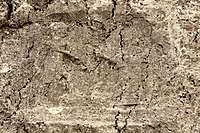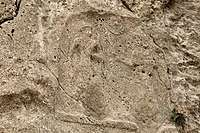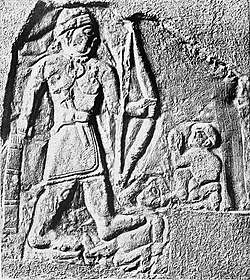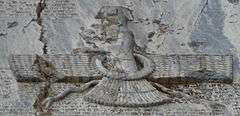Lullubi
The Lullubi or Lulubi (Akkadian: 𒇻𒇻𒉈: Lu-lu-bi, Akkadian: 𒇻𒇻𒉈𒆠: Lu-lu-biki "Country of the Lullubi") were a group of pre-Iranian tribes during the 3rd millennium BC, from a region known as Lulubum, now the Sharazor plain of the Zagros Mountains of modern Iraqi Kurdistan, and the Kermanshah Province of Iran. Lullubi was neighbour and sometimes ally with the Simurrum kingdom.[1] Frayne (1990) identified their city Lulubuna or Luluban with the region's modern Iraqi town of Halabja.
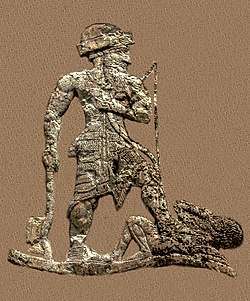
Lullubi Kingdom 𒇻𒇻𒉈𒆠 | |
|---|---|
| 2300 BC–675 BC | |
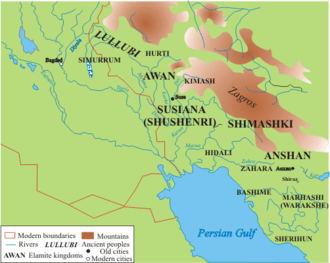 Territory of the Lullubi in the Mesopotamia area. | |
| Common languages | Unclassified Akkadian (inscriptions) |
| Religion | Mesopotamian religions |
| Government | Monarchy |
| Historical era | Antiquity |
• Established | 2300 BC |
• Disestablished | 675 BC |
| Today part of | Iraq Iran |
The language of the Lullubi is regarded as an unclassified language[3] due to the complete absence of any literature or written script, meaning it cannot be linked to known languages of the region at the time, such as Elamite, Hurrian, Sumerian, Akkadian, Hattic and Amorite, and the Lullubi pre-date the arrival of Iranian-speakers by many centuries. The term Lullubi though, appears to be of Hurrian origin.[4]
Historical references
The early Sumerian legend "Lugalbanda and the Anzud Bird", set in the reign of Enmerkar of Uruk, alludes to the "mountains of Lulubi" as being where the character of Lugalbanda encounters the gigantic Anzû bird while searching for the rest of Enmerkar's army en route to siege Aratta.
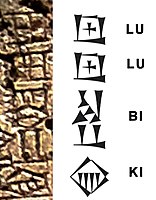

Lullubum appears in historical times as one of the lands Sargon the Great subjugated within his Akkadian Empire, along with the neighboring province of Gutium, which was probably of the same origin as the Lullubi. Sargon's grandson Naram Sin defeated the Lullubi and their king Satuni, and had his famous victory stele made in commemoration:
"Naram-Sin the powerful . . . . Sidur and Sutuni, princes of the Lulubi, gathered together and they made war against me."
After the Akkadian Empire fell to the Gutians, the Lullubians rebelled against the Gutian king Erridupizir, according to the latter's inscriptions:
Ka-Nisba, king of Simurrum, instigated the people of Simurrum and Lullubi to revolt. Amnili, general of [the enemy Lullubi]... made the land [rebel]... Erridu-pizir, the mighty, king of Gutium and of the four quarters hastened [to confront] him... In a single day he captured the pass of Urbillum at Mount Mummum. Further, he captured Nirishuha.
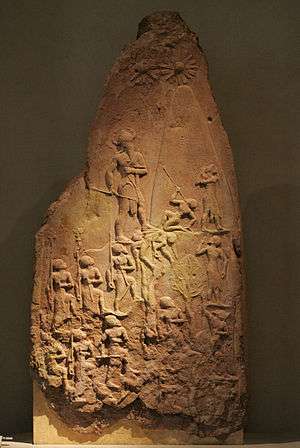
Following the Gutian period, the Neo-Sumerian Empire (Ur-III) ruler Shulgi is said to have raided Lullubi at least 9 times; by the time of Amar-Sin, Lullubians formed a contingent in the military of Ur, suggesting that the region was then under Neo-Sumerian control.
Another famous rock relief depicting the Lullubian king Anubanini with the Assyrian-Babylonian goddess Ishtar, captives in tow, is now thought to date to the Ur-III period; however, a later Babylonian legendary retelling of the exploits of Sargon the Great mentions Anubanini as one of his opponents.
In the following (second) millennium BC, the term "Lullubi" or "Lullu" seems to have become a generic Babylonian/Assyrian term for "highlander", while the original region of Lullubi was also known as Zamua. However, the "land of Lullubi" makes a reappearance in the late 12th century BC, when both Nebuchadnezzar I of Babylon (in c. 1120 BC) and Tiglath-Pileser I of Assyria (in 1113 BC) claim to have subdued it. Neo-Assyrian kings of the following centuries also recorded campaigns and conquests in the area of Lullubum / Zamua. Most notably, Ashur-nasir-pal II had to suppress a revolt among the Lullubian / Zamuan chiefs in 881 BC, during which they constructed a wall in the Bazian pass (between modern Kirkuk and Sulaymaniyah) in a failed attempt to keep the Assyrians out.
They were said to have had 19 walled cities in their land, as well as a large supply of horses, cattle, metals, textiles and wine, which were carried off by Ashur-nasir-pal. Local chiefs or governors of the Zamua region continued to be mentioned down to the end of Esarhaddon's reign (669 BC).
Representations
In depictions of them, the Lullubi are represented as warlike mountainers.[9] The Lullubi are often shown bare-chested and wearing animal skins. They have short beards, their hair is long and worn in a thick braid, as can be seen on the Victory Stele of Naram-Sin.[8]
Rulers
Rulers of the Lullubi kingdom:[10][11]
- Immashkush (c. 2400 BC)[12]
- Anubanini (c. 2350 BC) he ordered to make an inscription on the rock near Sar-e Pol-e Zahab.[13]
- Satuni (c. 2270 BC contemporary with Naram-Sin king of Akkad and Khita king of Awan)
- Irib (c. 2037 BC)
- Darianam (c. 2000 BC)
- Ikki (precise dates unknown)[13]
- Tar ... duni (precise dates unknown) son of Ikki. His inscription is found not far from the inscription of Anubanini.[13]
- Nur-Adad (c. 881 – 880 BC)
- Zabini (c. 881 BC)
- Hubaia (c. 830 BC) vassal of Assyrians
- Dada (c. 715 BC)
- Larkutla (c. 675 BC)
Lullubi rock reliefs
Various Lullubian reliefs can be seen in the area of Sar-e Pol-e Zohab, the best preserved of which is the Anubanini rock relief. They all show a ruler trampling an enemy, and most also show a deity facing the ruler. Another relief can be found about 200 meters away, in a style similar to the Anubanini relief, but this time with a beardless ruler.[2] The attribution to a specific ruler remains uncertain.[2][14]
Anubanini rock relief
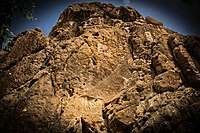 The relief is located on the top of a cliff towering over the village of Sarpol-e Zahab. A second relief (Parthian Empire period) appears below.
The relief is located on the top of a cliff towering over the village of Sarpol-e Zahab. A second relief (Parthian Empire period) appears below.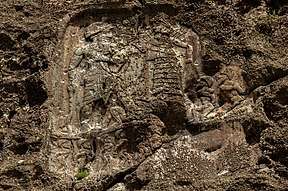

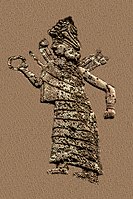
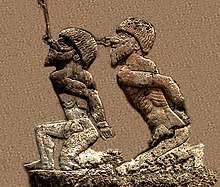 Prisoners of the Lullubis (detail).[2]
Prisoners of the Lullubis (detail).[2]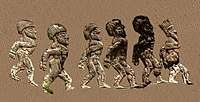 Prisoners of the Lullubis and their king (detail).[2]
Prisoners of the Lullubis and their king (detail).[2]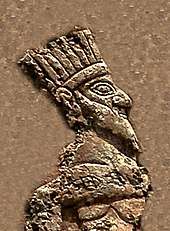 Prisoner king (detail). He appears to be wearing a crown.[2]
Prisoner king (detail). He appears to be wearing a crown.[2]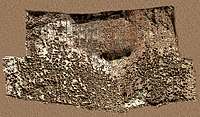 Anubanini rock relief Akkadian inscription.[2]
Anubanini rock relief Akkadian inscription.[2]
Other Lullubi reliefs
See also
- Anobanini rock relief
- Zamua
References
- Hamblin, William J. (2006). Warfare in the Ancient Near East to 1600 BC. Routledge. pp. 115–116.
- Osborne, James F. (2014). Approaching Monumentality in Archaeology. SUNY Press. p. 123. ISBN 9781438453255.
- "The Languages of the Ancient Near East (in A Companion to the Ancient Near East, 2nd ed., 2007)".
- Tischler 1977–2001: vol. 5/6: 70–71. On the Lullubeans in general, see Klengel 1987–1990; Eidem 1992: 50–4.
- Babylonian & Oriental Record. 1895. p. 27.
- Hamblin, William J. (2006). Warfare in the Ancient Near East to 1600 BC. Routledge. pp. 115–116.
- "Louvre Museum Official Website". cartelen.louvre.fr.
- "The hair of the Lullubi is long and worn in a thick braid. They wear animal skins, while the Akkadian soldiers wear the proper attire for battle, helmets and military tunics." in Bahrani, Zainab (2008). Rituals of War: The Body and Violence in Mesopotamia. Zone Books. p. 109. ISBN 9781890951849.
- Bury, John Bagnell; Cook, Stanley Arthur; Adcock, Frank Ezra (1975). The Cambridge Ancient History: The Egyptian and Hittite empires to c. 1000 B.C. University Press. p. 505.
- Qashqai, 2011.
- Legrain, 1922; Cameron, 1936; D’yakonov, 1956; The Cambridge History of Iran; Hinz, 1972; The Cambridge Ancient History; Majidzadeh, 1991; Majidzadeh, 1997.
- Cameron, George G. (1936). History of Early Iran (PDF). The University of Chicago Press. p. 35.
- Cameron, George G. (1936). History of Early Iran (PDF). The University of Chicago Press. p. 41.
- Vanden Berghe, Louis. Relief Sculptures de Iran Ancien. pp. 19–21.
- Osborne, James F. (2014). Approaching Monumentality in Archaeology. SUNY Press. pp. 123–124. ISBN 9781438453255.
- Osborne, James F. (2014). Approaching Monumentality in Archaeology. SUNY Press. pp. 123–124. ISBN 9781438453255.
- Frayne, Douglas (1990). Old Babylonian Period (2003-1595 BC). University of Toronto Press. pp. 707 ff. ISBN 9780802058737.
Sources
- Sar-e Pol-e Zahab
- Lullubi
- Qashqai, Hamidreza, Chronicle of early Iran history, Tehran, Avegan press, 2011 (in Persian: گاهنمای سپیده دم تاریخ در ایران )
- Cameron, George, "History of Early Iran", Chicago, 1936 (repr., Chicago, 1969; tr. E.-J. Levin, L’histoire de l’Iran antique, Paris, 1937; tr. H. Anusheh, ایران در سپیده دم تاریخ, Tehran, 1993)
- D’yakonov, I. M., "Istoriya Midii ot drevenĭshikh vremen do kontsa IV beka de e.E" (The history of Media from ancient times to the end of the 4th century BCE), Moscow and Leningrad, 1956; tr. Karim Kešāvarz as Tāriḵ-e Mād, Tehran, 1966.
- The Cambridge History of Iran
- Hinz, W., "The Lost World of Elam", London, 1972 (tr. F. Firuznia, دنیای گمشده ایلام, Tehran, 1992)
- The Cambridge Ancient History
- Majidzadeh, Yusef, "History and civilization of Elam", Tehran, Iran University Press, 1991.
- Majidzadeh, Yusef, "History and civilization of Mesopotamia", Tehran, Iran University Press, 1997, vol.1.
- Legrain, Leon, "Historical Fragments", Philadelphia, The University of Pennsylvania Museum Publications of the Babylonian Section, vol. XIII, 1922.
- Vallat, Francois. Elam: The History of Elam. Encyclopaedia Iranica, vol. VIII pp. 301-313. London/New York, 1998.

.jpg)

